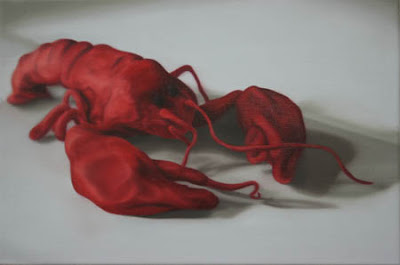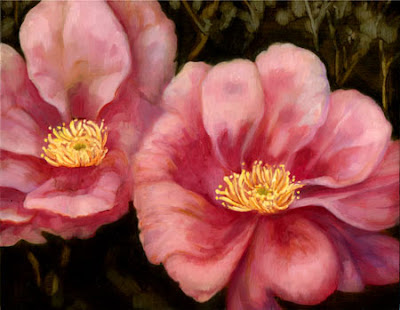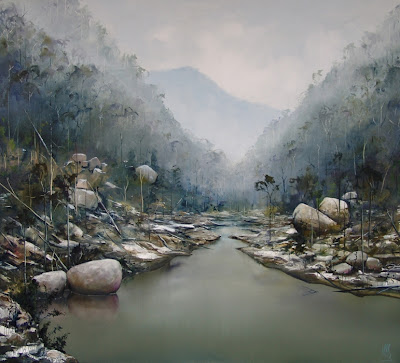Art Life contributor Ian Houston reports from our second art strip – Queen Street, Paddington – an assignment he took up with gusto…
Welcome readers. Today finds us in the heart of the Wentworth electorate, a blue ribbon Liberal seat, that Malcolm Turnbull, future leader of the Liberal party and former Republican, confidently held in the recent federal election. Well done Malcolm. Malcolm assures us that Wentworth is the soul of egalitarianism and sure enough, here on Queen street in the very centre of Wentworth, the great diversity of Australian culture can be seen everywhere you look. Whether its the fusion cuisine of Bistro Moncur, the many galleries selling contemporary canvas paintings, the stores selling rugs from the orient or boutiques stuffed to the rafters with French antiques, Woolahra is bubbling over with the egalitarian ethos for whoever can afford it.
So lets set off then in search of art.

Peter Olive, Reclining Nude, 2007.
Courtesy Dickerson Gallery
Only a short stroll from the 380 bus stop, away from the noisy and unsettling Oxford street and towards Woolahra’s café heartland we find the first of today’s galleries. Dickerson Gallery has a show by Peter Olive, his fifth there since ’97, so things must be going well between them. Mr Olive paints very respectable oil paintings. He’s a marvellous technician with a beautiful palette. His best works have a quiet intensity within which the drama lies in the paints patina, a smoky, pale heat that works across every edge of the canvas. Reclining nude is a strong genre work, that details the painter’s grasp of the idiomatic gesture, working at once as a technical exercise and a commentary on the act of painting itself. Similarly his domestic still-lives and landscapes exhibit the same sure hand. Satisfying paintings with impeccable credentials. One can sense an interest in Lucien Freud‘s work though tempered less by the lugubrious and more by such orthodox concerns as light and form. His subject matter, however, seemed to veer with little discretion from the domestic and genre work to the political, giving the show an uneven tone. I took more pleasure from the execution than the subject matter in works such as The Last Tasmanian Tiger if only for my fear of the preacher’s tone. But these are quibbles with what is an enjoyable exhibition.

Amanda Marburg, Lobster, 2007.
Courtesy Rex Irwin Art Dealer.
Rex Irwin Art Dealer has a very interesting show from Amanda Marburg. I saw Marburg’s work for the first time at this year’s Primavera and was impressed with the conceptualisation and the manner in which it had been executed. Plasticine models are created and then used as the subjects for very accurate oil paintings, rendered with a flawless technique. In the case of the Primavera show, the paintings were monotone whereas the Irwin show Lobster is in glorious Technicolor. This idea of rendering the subject in a clumsy medium like plasticine only to paint it exactingly in oils on linen is an amusing engagement with the problem of mimesis and reproduction, though it does have the slight whiff of the gimmick. It would be sad to see someone becoming tied to such a tightly conceptualised understanding, no matter how satisfyingly it dealt with certain difficulties in the conceptualisation of the art object. Especially when the artist is so clearly in control of her medium. That aside and the show is archly enjoyable. Particularly given the subject matter, the book Lobster by Guillaume Lecasble. To give you a taste of its joys I include the blurb from its front cover flap,
“Aboard the Titanic, Lobster watches Angelina devour his father, before being plucked out of the aquarium himself. Just as he is put in the boiling pot, the ship hits the iceberg and the pot is thrown to the floor. Lobster survives, with some changes; he finds himself sexually attracted not only to a human, but to the very human who ate his father. He gives her one life-changing orgasm before their tragic separation, following an ugly incident in one of the lifeboats.”
The paintings are for the most part, mid sized, deliciously finished and eminently collectible if one had an idle twenty G lying ’round the house. Certainly worth a trip up the stairs.

Adriane Strampp, Garden 11, 2007.
Courtesy Eva Bruer Fine Art.
I always find a visit to Eva Bruer‘s gallery a little unnerving, fearing that the quality of my attire shall reveal my true provenance as a freeloading parasite. But I manage to avoid any ejection on account of sartorial failures or perceived penury and skip joyfully past the major Australian names to the current “live” artist show Adriane Strampp. Adriane’s paintings are small, highly finished and for the most part very pretty. They are, not to put too fine a point on it, flower paintings. They try to dress this up a bit, talking about historic appropriation, name checking Bronzino, discussing narrative arcs and quoting bits and pieces of Virgina Woolf‘s girlfriend, the poet, and incredibly rich bon vivant, Vita Sackville-West, but I wasn’t fooled. These were paintings of flowers, not fragmented narratives. If you like painting flowers, cool. Flowers are beautiful, ergo paintings of them probably will be to, especially ones sourced from “renaissance masters”. All in all these reminded me of nothing so much as maquettes for a Tim Macguire show, beautiful certainly, but not entirely satisfying. And here and there technical consideration brought them dangerously close to kitsch. Still the people must have liked it, there were enough red dots to make any gallery owner purr.

Christopher Lees, Alpine Stretch, 2007.
Courtesy Libby Edwards Galleries.
Libby Edwards Galleries Woollahra has a show by Christopher Lees with the engagingly unseasonable name Cold Snap, a series of largish oils depicting various aspects of “wild Australia”. These paintings use a variety of techniques to achieve an almost photo real quality in their representation of gum trees, water and boulders at the same time as introducing obvious artifice in gestures that acknowledge the technical quality of the work. They reminded me of some almost supernatural cross between Tim Storrier, Pro Hart and any member of the Boyd family you care to name. They were certainly not to my taste and I found it difficult to understand why anyone would spend the kind of money the gallery was asking, even if you did have a feature wall. Needless to say, they were almost all sold.

Adam Rish, installation view.
Courtesy Michael Nagy Fine Art
I decided that my bourgeois taste for canvas painting had been satisfied to the point of surfeit, so I ventured cross town to that wiggly-waggly Woolahra Paddington area to have a look at the Michael Nagy Fine Art. It was with some relief that I found an exhibition of sculpture by the mischievous Adam Rish called Ethnographia. Here, Rish riffs on his usual cross cultural shtick, in this instance life-size wooden sculptures made in collaboration with a Balinese woodcarver, who goes by the name of I Wayan Sumantra. Which is not to suggest that they draw on traditional Balinese memes, but instead, are inspired by the tau-tau spirit figures of Sulawesi and the traditional horse sculpture of Timor. Cross cultural? My fucking word! All in all its an engaging show, spirited, naughty, even beautiful at times, the bare wood grain revealing the works universal qualities just as contemporary technological references play against this. After all one can’t help but like a sculpture with a carrot up its bum.
So here ends my day in egalitarian Woolahra, a place where canvas painting continues to be the very cutting edge of contemporary art. Long may it rule, though I must admit, I feel slightly nauseous. Perhaps it was all those cappuccinos?

